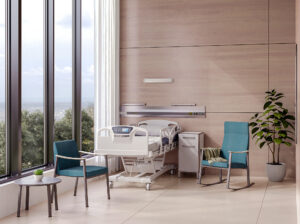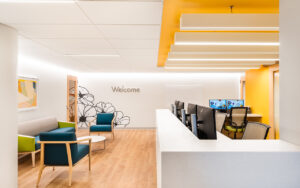By Lindsey Coulter
Healthcare environments continue to evolve as design teams integrate hospitality-inspired elements into health and wellness spaces. Many modern hospitals and clinics are designed with an increasing awareness of the colors, textures, acoustic qualities, adjacencies, and amenities that give patients and guests alike an optimal experience.
While design and construction play a significant role in delivering tailored, future-focused healthcare spaces, product developers and manufacturers are also helping drive progress in the interior space. Healthcare Construction + Operations News spoke with Ariel Schuster, director of sales and design at Artaic—which specializes in the design, fabrication and assembly of custom mosaics—and Ryan Smith, president and creative director at lighting and design studio LightArt. Several team members from Allseating—Lynette Taylor, regional sales director; Cindy Lawton-Moreby, vice president of sales; Stephanie Smith, marketing director; and Hope Myles, regional sales director and architect of the Allseating client experience—also weighed in on changing approaches to sustainability and the establishing a new bar for patient experience.
How have patient needs and expectations regarding healthcare spaces changed in recent years?
Schuster: There has been a significant shift toward creating environments that promote healing and instill a sense of calm. Biophilic designs and natural color palettes are increasingly used to create a warm, welcoming atmosphere that supports healing and overall well-being.

Ryan Smith: The biggest shift we’ve observed is a move away from sterile, clinical aesthetics towards warmer, more welcoming environments. Patients now expect healthcare spaces to feel less like hospitals and more like comfortable, non-threatening spaces. This has driven demand for design-forward materials that offer both functionality and a sense of well-being.
Myles: As (people) are living longer, it is becoming increasingly important to design mixed-use healthcare facilities that cater to the “active” aging population. Design and development of transitional patient furniture that allows different age groups to enjoy the same spaces should be an ongoing focus.
Taylor: Additionally, the pandemic accelerated the demand for antimicrobial and easy-to-clean surfaces. Healthcare seating must now withstand frequent disinfecting without compromising durability or warranty. There’s also a stronger focus on inclusive design, ensuring seating accommodates diverse patient populations, including bariatric patients and those with mobility challenges (hip chairs, for example). This also includes catering to family involvement, with more comfortable seating in patient rooms, pull-out beds, and designated family zones in waiting areas. Finally, more healthcare facilities are prioritizing sustainable materials and incorporating nature-inspired designs. We see indoor and rooftop gardens, aquariums and quiet zones throughout hospitals.
What role do biophilic design principles play in the development of new products?
Schuster: A medical setting can often feel foreign and overwhelming, with everything from the technology to the terminology feeling unfamiliar. By contrast, humans have an innate connection to nature, and studies have shown that being surrounded by nature is beneficial to our overall health and well-being. When designing our mosaic collections for healthcare, we make a conscious effort to ensure that the color palettes and artistry adhere to biophilic principles, incorporating familiar patterns and natural hues.
Ryan Smith: Biophilic design is challenging in healthcare settings due to strict hygiene requirements. Our materials bridge this gap by recreating the look and feel of nature with durable, easily cleanable surfaces. We can encapsulate organic elements or use high-resolution printing to mimic natural textures, bringing the benefits of biophilia to healthcare without compromising cleanliness.
Stephanie Smith: Biophilic design is a significant and growing trend in healthcare, and while it mostly encompasses surrounding space vs. products in that space, the more Allseating can contribute by offering sustainable products, the more it can meet the needs of our clients. Our Greenhealth Approved certification is a declaration of Allseating’s commitment to the environment.

What challenges and opportunities do you encounter when developing products that are comfortable for patients while also being durable and sustainable?
Schuster: One challenge we continually assess is ensuring that we offer a comprehensive range of tile materials to suit every setting. For example, for high-traffic floors, hand-cut stone is excellent for wayfinding and displays text beautifully. For public art murals on walls, ½” vitreous glass tile reigns supreme, and for wet environments, flat grip porcelain provides the highest level of slip resistance.
Tiles offer many remarkable benefits in terms of durability and sustainability. Vitreous glass, sintered glass, and glazed porcelain are naturally non-porous, making them exceptionally durable and easy to clean. We have witnessed a welcomed shift towards sustainable materials and offer sintered glass—which is fantastic for all commercial settings, affordable and made of 100% post-consumer recycled material.
Stephanie Smith: A client’s budgetary constraints, coupled with the need for durability, offer opportunities to innovate and create products that are both comfortable for patients and sustainable for the environment. By carefully selecting materials and involving stakeholders early in the process, we can develop products that meet the diverse needs of our clients and their patients all while ensuring the end product meets the requirements of our 12-year warranty.
Lawton-Moreby: Space constraints also provide significant challenges to designing products that meet all of the functionality requirements. Design must factor in limitations to smaller space footprints within healthcare facilities.
What healthcare interior trends do you anticipate in the next five years?
Schuster: I believe biophilic design will remain a dominant trend in healthcare interiors. Organic elements, such as living walls, natural color palettes and nature-inspired patterns will increasingly become prevalent. Additionally, I foresee a shift toward heritage design, where healthcare spaces honor their local culture through public art and references to historical events, creating environments that promote healing and strengthen community identity.
Ryan Smith: We expect a continued focus on materials that elevate the patient experience. Healthcare spaces will increasingly utilize design elements that promote mental and emotional well-being, alongside the necessary functionality and durability.
Stephanie Smith: Trends will continue to focus on sustainability, modularity/flexibility, ergonomic design and infection prevention.
Lawton-Moreby: Ease-of-use and a more residential or hospitality feel in healthcare spaces will be prevalent.
Taylor: Integrated power solutions will become standard in patient rooms, waiting and public spaces and treatment rooms. Inclusion and accessibility will become even more mainstream, as well as infection prevention, sustainable design and behavioral health.


